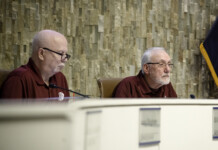
So just where is Pinal County headed? That was the question many have been asking and some tried to answer last Tuesday morning at the Future of Pinal meeting in Casa Grande. The meeting looked at a report from the Morrison Institute for Public Policy (School of Public Affairs, Arizona State University) that was commissioned by the Pinal County Board of Supervisors.
Pinal County Manager Terry Doolittle told the audience that this may be a critical time in Pinal County, but it is also an exciting time when it comes to the direction the county will take. “All eyes across the state are on us,” Doolittle said.
Pinal County Supervisor Lionel Ruiz said growth presents not only many challenges, but many opportunities. “Before we know where we are going, we need to know where we’re coming from,” Ruiz noted.
Rob Melnick, director of the Morrison Institute for Public Policy, said, “We know what the future of Pima and Maricopa Counties will look like, but not so for Pinal. “Pinal is at the fork in the road,” Melnick offered. “You can use this plan (Pinal County Comprehensive Plan) as a tool for how you want this recipe to turn out.” Melnick added that he sees Pinal County as having a sense of stewardship on how the place turns out. “This (Pinal County) is more a group of stewards than politicians,” Melnick said.
The event’s main speaker, Senior Research Fellow Grady Gammage, told attendees that Pinal County supervisors had asked a couple questions. They were: What will differentiate Pinal County? How do we ensure long-term livability and competitiveness?
“People want to know if Pinal County can be a place and not just a jurisdiction,” Gammage said. “This is the time to choose. People in Phoenix and Tucson look at Pinal County as a place you drive through. You can still be the county in between or you can become something distinctive. We’re asking you to write the scenario.”
The commute to work was one item that Gammage discussed, noting the median price for a new Pinal County home is about 20 to 25 percent less than in Maricopa County. “Half of Pinal’s brainpower leaves the region to work,” Gammage noted. “The ‘drive till you qualify’ phenomenon is well-known in Pinal,” Gammage added.
According to the report, the “drive till you qualify” phenomenon describes how many residents chose their current homes. However, with rising interest rates, higher gas prices and major road congestion now evident, the downsides of this pattern are being acknowledged. For example, Pinal’s foreclosure rate is around 50 percent higher than the national average, according to data supplied by Realty Trac. On the other hand home ownership, either for the first time or for a newer, bigger house than could be afforded elsewhere, continues to be a powerful draw.
Gammage went on to say that Pinal County has the opportunity to distinguish itself from both Maricopa and Pima Counties. As Gammage noted, there are six place-making goals for Pinal County that both leaders and residents have focused on.
Those place-making goals are: distinguishing Pinal County from both Maricopa and Pima Counties; protecting miles of desert and open land; providing choices for transportation and mobility; supporting unique, ‘fair share’ communities; creating and attracting ‘career pay – career path’ jobs and developing Pinal’s talent pool.
Keeping workers closer to home is one way to cut down on increasing commute times. Gammage noted Pinal County has the most needs per capita but the fewest resources when it comes to transportation. The Morrison Institute for Public Policy reported this year that Pinal County has $3.1 billion in just a few selected, high priority transportation projects. Among them is $187 million for improving SR 238 (Maricopa-Casa Grande Highway).
In conclusion, Gammage asked the audience to question what it wanted for Pinal County, giving them the choice of a McMega Drive Through or a Distinguishable Destination. “This is a chance to kick off dialogue as to what kind of county you want to be,” Gammage said. “We want to throw out provocative ideas for people to react to.”
Photo by Dave Thomas



![State: Pinal County fire activity concerning Tucson's Northwest Fire District crew members assist in firefighting efforts on the "Flying Bucket Fire" approximately 15 miles southwest of Maricopa on May 8, 2024. [Northwest Fire District]](https://www.inmaricopa.com/wp-content/uploads/2024/05/GNEq06pbwAA6JlT-218x150.jpg)


![Silk Press Xpress brings Southern hospitality Surrounded by Maricopa Chamber of Commerce Executive Director Kelly Anderson, Councilmember Henry Wade and Board Member Jeremy Waters, LaQuinta Fisher, center, smiles just before a ribbon cutting ceremony at her new salon Silk Press Xpress on April 6, 2024. [Monica D. Spencer]](https://www.inmaricopa.com/wp-content/uploads/2024/05/spencer-040624-silk-press-xpress-ribbon-cutting-web-02-218x150.jpg)
![‘Best moms’ InMaricopa recognized Best Mom's 2024 photo taken at Karsten's Ace Hardware on May 11th, 2024. [Bryan Mordt]](https://www.inmaricopa.com/wp-content/uploads/2024/05/Best-Mom-2024-1-218x150.jpg)



![Carl’s Jr plans to “open soon” An exterior view of the new Carl's Jr. restaurant along John Wayne Parkway on May 7, 2024. [Elias Weiss]](https://www.inmaricopa.com/wp-content/uploads/2024/05/E1C66482-CB4C-4FD0-BA30-35CECE93F4BE-218x150.jpeg)

![Traffic change to reduce backup at Villages intersection The intersection at Butterfield Parkway and West Edison Road on May 10, 2024. [Brian Petersheim Jr.]](https://www.inmaricopa.com/wp-content/uploads/2024/05/PJ_5644-218x150.jpg)


![State: Pinal County fire activity concerning Tucson's Northwest Fire District crew members assist in firefighting efforts on the "Flying Bucket Fire" approximately 15 miles southwest of Maricopa on May 8, 2024. [Northwest Fire District]](https://www.inmaricopa.com/wp-content/uploads/2024/05/GNEq06pbwAA6JlT-100x70.jpg)
